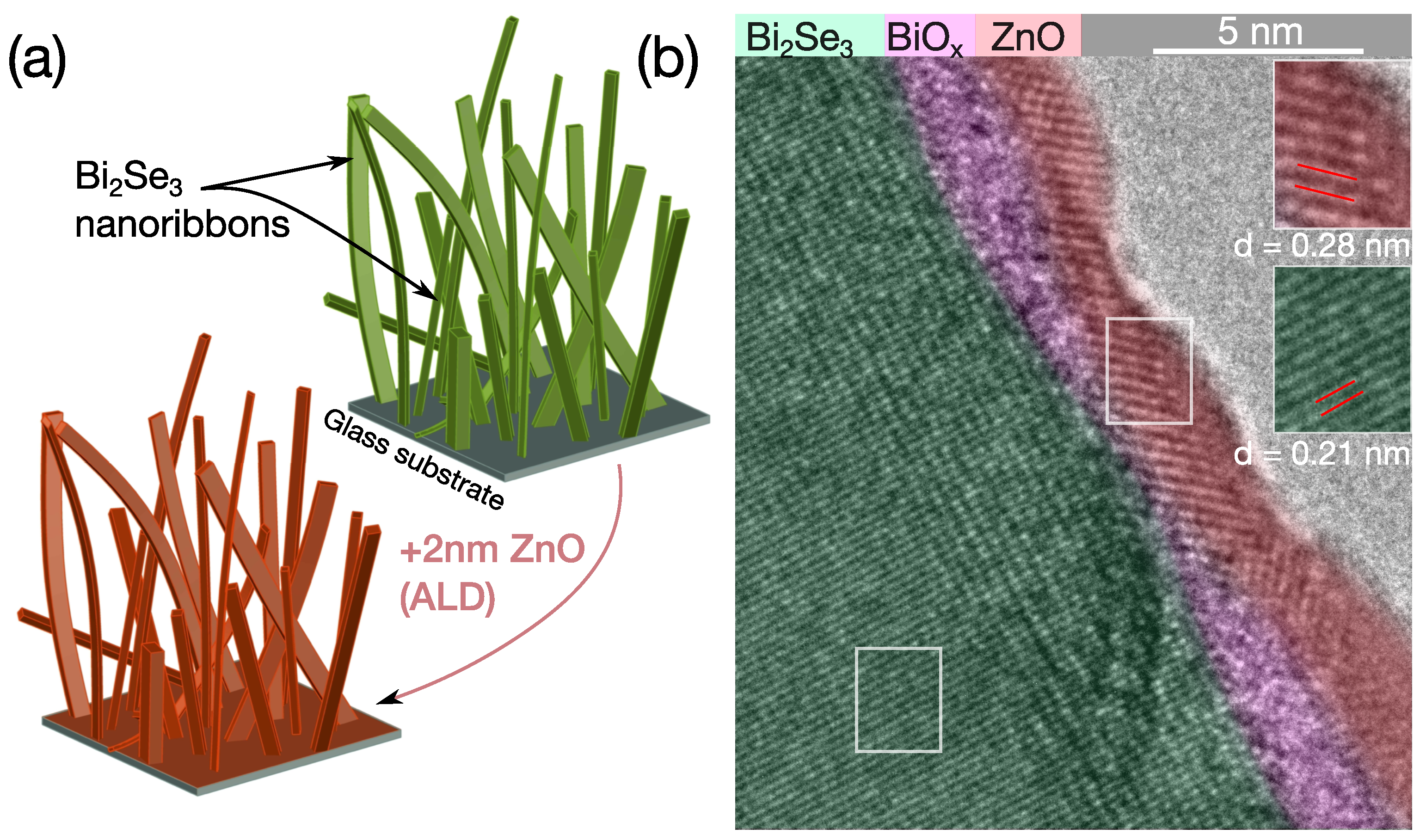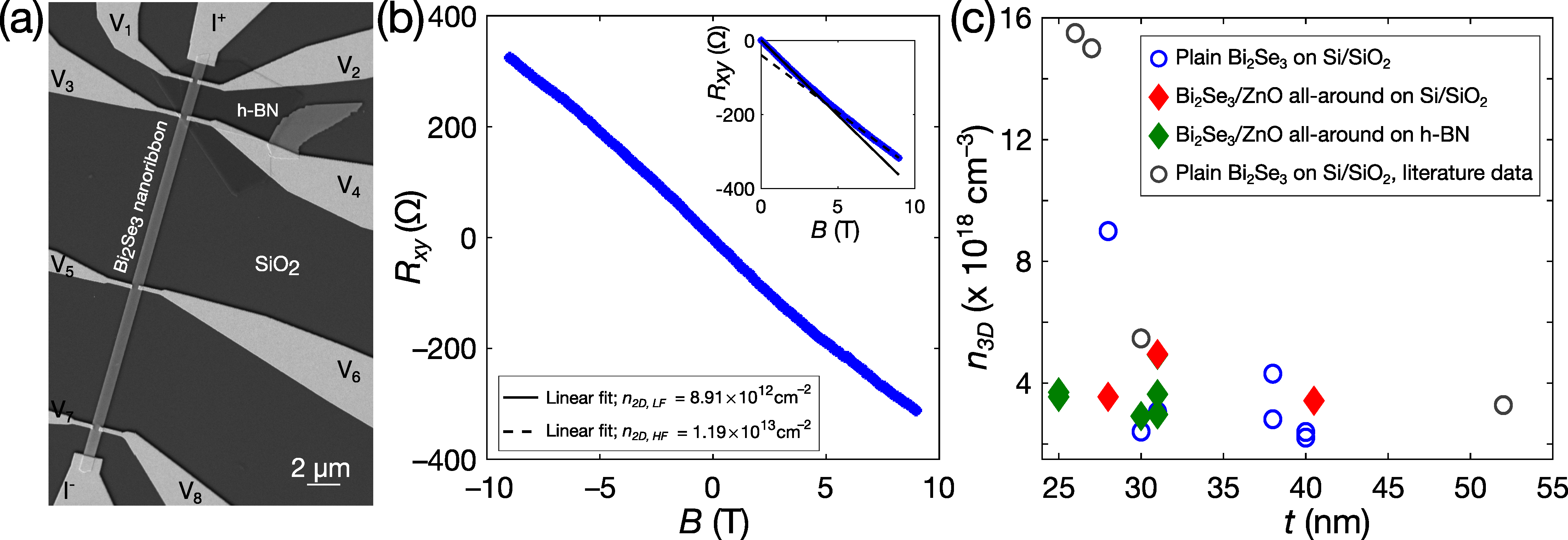Magnetotransport Studies of Encapsulated Topological Insulator Bi2Se3 Nanoribbons
Abstract
:1. Introduction
2. Materials and Methods
3. Results and Discussion
4. Conclusions
Supplementary Materials
Author Contributions
Funding
Institutional Review Board Statement
Informed Consent Statement
Data Availability Statement
Conflicts of Interest
References
- Zhang, H.; Liu, C.-X.; Qi, X.-L.; Dai, X.; Fang, Z.; Zhang, S.-C. Topological insulators in Bi2Se3, Bi2Te3 and Sb2Te3 with a single Dirac cone on the surface. Nat. Phys. 2009, 5, 438–442. [Google Scholar] [CrossRef]
- Hsieh, D.; Xia, Y.; Wray, L.; Qian, D.; Pal, A.; Dil, J.H.; Osterwalder, J.; Meier, F.; Bihlmayer, G.; Kane, C.L.; et al. Observation of Unconventional Quantum Spin Textures in Topological Insulators. Science 2009, 323, 919–922. [Google Scholar] [CrossRef] [PubMed] [Green Version]
- Hasan, M.Z.; Kane, C.L. Colloquium: Topological insulators. Rev. Mod. Phys. 2010, 82, 3045–3067. [Google Scholar] [CrossRef] [Green Version]
- Fu, L.; Kane, C.L. Superconducting Proximity Effect and Majorana Fermions at the Surface of a Topological Insulator. Phys. Rev. Lett. 2008, 100, 096407. [Google Scholar] [CrossRef] [Green Version]
- Fu, L.; Kane, C.L. Josephson current and noise at a superconductor/quantum-spin-Hall-insulator/superconductor junction. Phys. Rev. B 2009, 79, 161408. [Google Scholar] [CrossRef] [Green Version]
- Manousakis, J.; Altland, A.; Bagrets, D.; Egger, R.; Ando, Y. Majorana qubits in a topological insulator nanoribbon architecture. Phys. Rev. B 2017, 95, 165424. [Google Scholar] [CrossRef] [Green Version]
- Shiomi, Y.; Nomura, K.; Kajiwara, Y.; Eto, K.; Novak, M.; Segawa, K.; Ando, Y.; Saitoh, E. Spin-Electricity Conversion Induced by Spin Injection into Topological Insulators. Phys. Rev. Lett. 2014, 113, 196601. [Google Scholar] [CrossRef] [Green Version]
- Khokhriakov, D.; Hoque, A.M.; Karpiak, B.; Dash, S.P. Gate-tunable spin-galvanic effect in graphene-topological insulator van der Waals heterostructures at room temperature. Nat. Commun. 2020, 11, 3657. [Google Scholar] [CrossRef]
- Yasuda, K.; Mogi, M.; Yoshimi, R.; Tsukazaki, A.; Takahashi, K.S.; Kawasaki, M.; Kagawa, F.; Tokura, Y. Quantized chiral edge conduction on domain walls of a magnetic topological insulator. Science 2017, 358, 1311–1314. [Google Scholar] [CrossRef] [Green Version]
- Xue, L.; Zhou, P.; Zhang, C.X.; He, C.Y.; Hao, G.L.; Sun, L.; Zhong, J.X. First-principles study of native point defects in Bi2Se3. AIP Adv. 2013, 3, 052105. [Google Scholar] [CrossRef] [Green Version]
- Kunakova, G.; Surendran, A.P.; Montemurro, D.; Salvato, M.; Golubev, D.; Andzane, J.; Erts, D.; Bauch, T.; Lombardi, F. Topological insulator nanoribbon Josephson junctions: Evidence for size effects in transport properties. J. Appl. Phys. 2020, 128, 194304. [Google Scholar] [CrossRef]
- Xu, Y.; Miotkowski, I.; Liu, C.; Tian, J.; Nam, H.; Alidoust, N.; Hu, J.; Shih, C.-K.; Hasan, M.Z.; Chen, Y. Observation of topological surface state quantum Hall effect in an intrinsic three-dimensional topological insulator. Nat. Phys. 2014, 10, 956–963. [Google Scholar] [CrossRef] [Green Version]
- Hong, S.S.; Cha, J.J.; Kong, D.; Cui, Y. Ultra-low carrier concentration and surface-dominant transport in antimony-doped Bi2Se3 topological insulator nanoribbons. Nat. Commun. 2012, 3, 757. [Google Scholar] [CrossRef] [Green Version]
- Kunakova, G.; Galletti, L.; Charpentier, S.; Andzane, J.; Erts, D.; Léonard, F.; Spataru, C.D.; Bauch, T.; Lombardi, F. Bulk-free topological insulator Bi2Se3 nanoribbons with magnetotransport signatures of Dirac surface states. Nanoscale 2018, 10, 19595–19602. [Google Scholar] [CrossRef] [Green Version]
- Kunakova, G.; Bauch, T.; Palermo, X.; Salvato, M.; Andzane, J.; Erts, D.; Lombardi, F. High-Mobility Ambipolar Magnetotransport in Topological Insulator Bi2Se3 Nanoribbons. Phys. Rev. Appl. 2021, 16, 024038. [Google Scholar] [CrossRef]
- Brahlek, M.; Kim, Y.S.; Bansal, N.; Edrey, E.; Oh, S. Surface versus bulk state in topological insulator Bi2Se3 under environmental disorder. Appl. Phys. Lett. 2011, 99, 012109. [Google Scholar] [CrossRef] [Green Version]
- Veyrat, L.; Iacovella, F.; Dufouleur, J.; Nowka, C.; Funke, H.; Yang, M.; Escoffier, W.; Goiran, M.; Eichler, B.; Schmidt, O.G.; et al. Band Bending Inversion in Bi2Se3 Nanostructures. Nano Lett. 2015, 15, 7503–7507. [Google Scholar] [CrossRef] [Green Version]
- Brahlek, M.; Koirala, N.; Bansal, N.; Oh, S. Transport properties of topological insulators: Band bending, bulk metal-to-insulator transition, and weak anti-localization. Solid State Commun. 2015, 215–216, 54–62. [Google Scholar] [CrossRef] [Green Version]
- Kong, D.; Cha, J.J.; Lai, K.; Peng, H.; Analytis, J.G.; Meister, S.; Chen, Y.; Zhang, H.-J.; Fisher, I.R.; Shen, Z.-X.; et al. Rapid Surface Oxidation as a Source of Surface Degradation Factor for Bi2Se3. ACS Nano 2011, 5, 4698–4703. [Google Scholar] [CrossRef] [Green Version]
- Lang, M.; He, L.; Xiu, F.; Yu, X.; Tang, J.; Wang, Y.; Kou, X.; Jiang, W.; Fedorov, A.V.; Wang, K.L. Revelation of Topological Surface States in Bi2Se3 Thin Films by In Situ Al Passivation. ACS Nano 2012, 6, 295–302. [Google Scholar] [CrossRef] [PubMed]
- Ngabonziza, P.; Stehno, M.P.; Myoren, H.; Neumann, V.A.; Koster, G.; Brinkman, A. Gate-Tunable Transport Properties of In Situ Capped Bi2Te3 Topological Insulator Thin Films. Adv. Electron. Mater. 2016, 2, 1600157. [Google Scholar] [CrossRef] [Green Version]
- Andzane, J.; Kunakova, G.; Charpentier, S.; Hrkac, V.; Kienle, L.; Baitimirova, M.; Bauch, T.; Lombardi, F.; Erts, D. Catalyst-free vapour–solid technique for deposition of Bi2Te3and Bi2Se3nanowires/nanobelts with topological insulator properties. Nanoscale 2015, 7, 15935–15944. [Google Scholar] [CrossRef]
- Singh, A. Growth, Structural and Electrical Characterization of Topological Dirac Materials. Ph.D. Thesis, University of Cambridge, Cambridge, UK, 28 June 2018. [Google Scholar]
- Ghosh, R.; Kundu, S.; Majumder, R.; Roy, S.; Das, S.; Banerjee, A.; Guria, U.; Bera, M.K.; Subhedar, K.M.; Chowdhury, M.P.; et al. One-pot synthesis of multifunctional ZnO nanomaterials: Study of superhydrophobicity and UV photosensing property. Appl. Nanosci. 2019, 9, 1939–1952. [Google Scholar] [CrossRef]
- Ashcroft, N.W.; Mermin, N.D. Solid State Physics; Harcourt College Publishers: San Diego, CA, USA, 1976. [Google Scholar]
- Bansal, N.; Kim, Y.S.; Brahlek, M.; Edrey, E.; Oh, S. Thickness-Independent Transport Channels in Topological InsulatorBi2Se3Thin Films. Phys. Rev. Lett. 2012, 109, 116804. [Google Scholar] [CrossRef] [PubMed] [Green Version]
- Qu, D.-X.; Hor, Y.S.; Xiong, J.; Cava, R.J.; Ong, N.P. Quantum Oscillations and Hall Anomaly of Surface States in the Topological Insulator Bi2Te3. Science 2010, 329, 821–824. [Google Scholar] [CrossRef] [PubMed]
- Kunakova, G.; Meija, R.; Andzane, J.; Malinovskis, U.; Petersons, G.; Baitimirova, M.; Bechelany, M.; Bauch, T.; Lombardi, F.; Erts, D. Surface structure promoted high-yield growth and magnetotransport properties of Bi2Se3 nanoribbons. Sci. Rep. 2019, 9, 11328. [Google Scholar] [CrossRef] [PubMed] [Green Version]



| Surfaces (Band 1) | Bulk (Band 2) | Top Surface * | Bulk * | ||||
|---|---|---|---|---|---|---|---|
| ZnO/Bi2Se3 NR on h-BN: | tNR, nm | ||||||
| A3t | 29 | 6.43 × 1012 | 3540 | 4.74 × 1012/1.64 × 1018 | 930 | ||
| A1b | 35 | 7.18 × 1012 | 4700 | 5.31 × 1012/1.52 × 1018 | 2052 | 2.40 × 1012 | 1.44 × 1018 |
| D3b | 34 | 6.24 × 1012 | 4800 | 4.99 × 1012/1.46 × 1018 | 1350 | ||
| Bi2Se3 NR on SiO2, sample E5 [14] | 30 | 15.0 × 1012 ** | 2.40 × 1012 | ||||
| Bi2Se3 NR on SiO2, sample BR3-10R2 [14] | 63 | - | 2.50 × 1012 | 1.70 × 1018 | |||
| Bi2Se3 NR on SiO2, sample E [17] | 79 | 13.0 × 1012 * | 2.90 × 1012 | 6.60 × 1017 | |||
| Bi2Se3 NR on STO, sample B51-10 [15] | 9 | 5.55 × 1012 ** | 1232 | ||||
Publisher’s Note: MDPI stays neutral with regard to jurisdictional claims in published maps and institutional affiliations. |
© 2022 by the authors. Licensee MDPI, Basel, Switzerland. This article is an open access article distributed under the terms and conditions of the Creative Commons Attribution (CC BY) license (https://creativecommons.org/licenses/by/4.0/).
Share and Cite
Kunakova, G.; Kauranens, E.; Niherysh, K.; Bechelany, M.; Smits, K.; Mozolevskis, G.; Bauch, T.; Lombardi, F.; Erts, D. Magnetotransport Studies of Encapsulated Topological Insulator Bi2Se3 Nanoribbons. Nanomaterials 2022, 12, 768. https://doi.org/10.3390/nano12050768
Kunakova G, Kauranens E, Niherysh K, Bechelany M, Smits K, Mozolevskis G, Bauch T, Lombardi F, Erts D. Magnetotransport Studies of Encapsulated Topological Insulator Bi2Se3 Nanoribbons. Nanomaterials. 2022; 12(5):768. https://doi.org/10.3390/nano12050768
Chicago/Turabian StyleKunakova, Gunta, Edijs Kauranens, Kiryl Niherysh, Mikhael Bechelany, Krisjanis Smits, Gatis Mozolevskis, Thilo Bauch, Floriana Lombardi, and Donats Erts. 2022. "Magnetotransport Studies of Encapsulated Topological Insulator Bi2Se3 Nanoribbons" Nanomaterials 12, no. 5: 768. https://doi.org/10.3390/nano12050768
APA StyleKunakova, G., Kauranens, E., Niherysh, K., Bechelany, M., Smits, K., Mozolevskis, G., Bauch, T., Lombardi, F., & Erts, D. (2022). Magnetotransport Studies of Encapsulated Topological Insulator Bi2Se3 Nanoribbons. Nanomaterials, 12(5), 768. https://doi.org/10.3390/nano12050768








